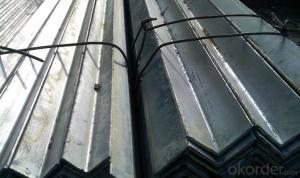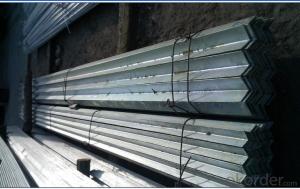Angle steel for sale with high quality ;
- Loading Port:
- Shanghai
- Payment Terms:
- TT OR LC
- Min Order Qty:
- 50 m.t.
- Supply Capability:
- 10000 m.t./month
OKorder Service Pledge
OKorder Financial Service
You Might Also Like
Product Description:
Specifications of Angle Steel
1. Invoicing on theoretical weight or actual weight as customer request
2. Length: 6m, 9m, 12m as following table
3. Sizes

Sizes: 25mm-250mm | ||
a*t | ||
25*2.5-4.0 | 70*6.0-9.0 | 130*9.0-15 |
30*2.5-6.6 | 75*6.0-9.0 | 140*10-14 |
36*3.0-5.0 | 80*5.0-10 | 150*10-20 |
38*2.3-6.0 | 90*7.0-10 | 160*10-16 |
40*3.0-5.0 | 100*6.0-12 | 175*12-15 |
45*4.0-6.0 | 110*8.0-10 | 180*12-18 |
50*4.0-6.0 | 120*6.0-15 | 200*14-25 |
60*4.0-8.0 | 125*8.0-14 | 250*25 |
5. Payment terms:
1).100% irrevocable L/C at sight.
2).30% T/T prepaid and the balance against the copy of B/L.
3).30% T/T prepaid and the balance against L/C
6.Material details:
Alloy No | Grade | Element (%) | |||||
C | Mn | S | P | Si | |||
Q235 | B | 0.12—0.20 | 0.3—0.7 | ≤0.045 | ≤0.045 | ≤0.3 | |
Alloy No | Grade | Yielding strength point( Mpa) | |||||
Thickness (mm) | |||||||
≤16 | >16--40 | >40--60 | >60--100 | ||||
≥ | |||||||
Q235 | B | 235 | 225 | 215 | 205 | ||
Alloy No | Grade | Tensile strength (Mpa) | Elongation after fracture (%) | ||||
Thickness (mm) | |||||||
≤16 | >16--40 | >40--60 | >60--100 | ||||
≥ | |||||||
Q235 | B | 375--500 | 26 | 25 | 24 | 23 | |
Usage & Applications of Angle Steel
According to the needs of different structures, Angle can compose to different force support component, and also can be the connections between components. It is widely used in various building structures and engineering structures such as roof beams, bridges, transmission towers, hoisting machinery and transport machinery, ships, industrial furnaces, reaction tower, container frame and warehouse etc.
Packaging & Delivery of Angle Steel
1. Packing: it is nude packed in bundles by steel wire rod
2. Bundle weight: not more than 3.5MT for bulk vessel; less than 3 MT for container load
3. Marks:
Color marking: There will be color marking on both end of the bundle for the cargo delivered by bulk vessel. That makes it easily to distinguish at the destination port.
Tag mark: there will be tag mark tied up on the bundles. The information usually including supplier logo and name, product name, made in China, shipping marks and other information request by the customer.
If loading by container the marking is not needed, but we will prepare it as customer request.
Production flow of Angle Steel
Material prepare (billet) —heat up—rough rolling—precision rolling—cooling—packing—storage and transportation
- Q:Can steel angles be used in seismic-resistant structures?
- Yes, steel angles can be used in seismic-resistant structures. They are commonly used as structural members in seismic-resistant construction due to their ability to resist lateral forces and provide stability during earthquakes. Steel angles are strong and rigid, making them suitable for withstanding the dynamic loads and vibrations associated with seismic events.
- Q:What are the common surface treatments for steel angles to enhance corrosion resistance?
- The common surface treatments for steel angles to enhance corrosion resistance include galvanizing, painting, and powder coating.
- Q:What is the maximum thickness of a steel angle?
- The maximum thickness of a steel angle is typically determined by the manufacturing process and the specific requirements of the application. Generally, steel angles can range in thickness from 1/8 inch to several inches. However, it is important to note that the availability of thicker steel angles may vary depending on the supplier and the specific grade of steel being used. In order to determine the maximum thickness of a steel angle for a particular project, it is recommended to consult with a structural engineer or a steel supplier who can provide guidance based on the specific requirements and load-bearing capacities needed.
- Q:What are the different methods of connecting steel angles?
- There are several methods of connecting steel angles, depending on the specific application and desired level of strength and durability. Some common methods include welding, bolting, and using mechanical connectors. 1. Welding: Welding is a widely used method of connecting steel angles. It involves melting the metals at the joint and allowing them to cool and solidify, creating a strong and permanent bond. Welding can be done using various techniques such as arc welding, MIG welding, or TIG welding. It provides a high level of strength and rigidity to the connection. 2. Bolting: Bolting is another common method of connecting steel angles. It involves using bolts, nuts, and washers to secure the angles together. This method allows for easy disassembly and reassembly if needed. Bolts can be tightened to achieve the desired level of tightness and strength in the connection. However, bolting may not offer the same level of strength as welding in certain applications. 3. Mechanical connectors: Mechanical connectors provide an alternative to welding and bolting for connecting steel angles. They are pre-engineered devices specifically designed for connecting steel members. These connectors typically consist of plates, brackets, or clips that are fastened to the angles using bolts or screws. Mechanical connectors offer ease of installation, flexibility, and the ability to accommodate movement and adjustments. 4. Adhesive bonding: Adhesive bonding involves using industrial-grade adhesives to join steel angles together. This method can provide a strong and durable connection, particularly when used in conjunction with mechanical fasteners. Adhesive bonding is often used in applications where welding or bolting may not be suitable or practical. It is important to consider factors such as load-bearing capacity, environmental conditions, and aesthetic requirements when selecting the appropriate method of connecting steel angles. Consulting with a structural engineer or a professional experienced in steel fabrication can help determine the most suitable connection method for a specific project.
- Q:Can steel angles be used for load-bearing walls?
- Yes, steel angles can be used for load-bearing walls. Steel angles are commonly used in construction as a structural element to provide support and stability. They are often used to reinforce load-bearing walls by adding strength and rigidity. Steel angles can be used to distribute the weight of a load evenly, making them suitable for load-bearing applications. However, it is important to ensure that the steel angles are appropriately designed and installed to meet the specific load requirements of the wall. Consulting with a structural engineer or construction professional is recommended to ensure the proper use of steel angles for load-bearing walls.
- Q:What are the different methods for strengthening steel angles?
- There are several methods for strengthening steel angles, including heat treatment, cold working, and alloying. Heat treatment involves heating the steel to a specific temperature and then cooling it rapidly to increase its hardness and strength. Cold working, on the other hand, involves deforming the steel at room temperature to enhance its strength. Alloying is another method where additional elements are added to the steel to improve its strength and other properties.
- Q:What is the maximum deflection for a steel angle beam?
- The maximum deflection for a steel angle beam depends on several factors including the dimensions of the beam, the material properties of the steel, and the applied load. It is calculated using engineering principles and can be determined using formulas and calculations specific to the beam's geometry and loading conditions. Therefore, without specific information about these factors, it is not possible to provide a definitive answer to the maximum deflection of a steel angle beam.
- Q:Can steel angles be used for sound barriers?
- Yes, steel angles can be used for sound barriers. Steel angles are commonly used in construction and can be suitable for sound barrier applications due to their durability, strength, and ability to absorb and block sound.
- Q:How do steel angles perform in corrosive environments?
- Steel angles perform well in corrosive environments due to their high resistance to corrosion. The presence of alloying elements such as chromium, nickel, and molybdenum in the steel composition enhances its ability to withstand corrosion caused by moisture, chemicals, and other corrosive agents. Additionally, the angles can be further protected through coatings or treatments, such as galvanization or painting, to provide an added layer of defense against corrosion.
- Q:How do steel angles perform in chemical industry applications?
- Steel angles are commonly used in chemical industry applications due to their excellent strength, durability, and corrosion resistance. They can withstand harsh chemical environments, making them ideal for supporting structures, platforms, and equipment in chemical plants. Additionally, steel angles can be easily welded, providing flexibility in design and construction.
1. Manufacturer Overview |
|
|---|---|
| Location | |
| Year Established | |
| Annual Output Value | |
| Main Markets | |
| Company Certifications | |
2. Manufacturer Certificates |
|
|---|---|
| a) Certification Name | |
| Range | |
| Reference | |
| Validity Period | |
3. Manufacturer Capability |
|
|---|---|
| a)Trade Capacity | |
| Nearest Port | |
| Export Percentage | |
| No.of Employees in Trade Department | |
| Language Spoken: | |
| b)Factory Information | |
| Factory Size: | |
| No. of Production Lines | |
| Contract Manufacturing | |
| Product Price Range | |
Send your message to us
Angle steel for sale with high quality ;
- Loading Port:
- Shanghai
- Payment Terms:
- TT OR LC
- Min Order Qty:
- 50 m.t.
- Supply Capability:
- 10000 m.t./month
OKorder Service Pledge
OKorder Financial Service
Similar products
New products
Hot products
Related keywords




























